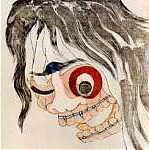I was mildly bemused to arrive home around 11:45pm last night to find this in the mailbox:
So the police called to say nothing is out of the ordinary? Evidently not long before I got home. Strange... But TIJ and all that.
| Hot Topics | |
|---|---|
Late-night visit from Pipo-kun
14 posts
• Page 1 of 1
Late-night visit from Pipo-kun
You do not have the required permissions to view the files attached to this post.
-

yanpa - Posts: 5671
- Images: 11
- Joined: Sun Nov 04, 2007 11:50 am
- Location: Tokyo
Re: Late-night visit from Pipo-kun
Is it another medieval monthy python skit...
guard at the watchtower: "it is midnight, all is quite..."
guard at the watchtower: "it is midnight, all is quite..."
-

Coligny - Posts: 21822
- Images: 10
- Joined: Sat Jan 17, 2009 8:12 pm
- Location: Mostly big mouth and bad ideas...
Re: Late-night visit from Pipo-kun
Maybe some neighbor called them to complain about the sound your fridge was making...
“To learn who rules over you, simply find out who you are not allowed to criticize.”
“I know not with what weapons World War III will be fought, but World War IV will be fought with sticks and stones.” ― Albert Einstein
-

Russell - Maezumo
- Posts: 8580
- Images: 1
- Joined: Fri Aug 13, 2010 11:51 pm
Re: Late-night visit from Pipo-kun
It's a little unnerving that the pigs don't consider prowling around a gaijin's home near the Cinderella hour as 異常
-

Screwed-down Hairdo - Maezumo
- Posts: 6721
- Joined: Wed May 20, 2009 7:03 pm
Re: Late-night visit from Pipo-kun
yanpa wrote:I was mildly bemused to arrive home around 11:45pm last night to find this in the mailbox:
So the police called to say nothing is out of the ordinary? Evidently not long before I got home. Strange... But TIJ and all that.
I remember getting one of these years ago (also 異常なし). They will note down things like unlocked windows, etc. They do this for all the houses in the neighbourhood, not just ayashii gaijin.
-

BigInJapan - Maezumo
- Posts: 1140
- Joined: Thu May 14, 2009 6:45 pm
- Location: Down south (but from the Great White North)
Re: Late-night visit from Pipo-kun
Screwed-down Hairdo wrote:It's a little unnerving that the pigs don't consider prowling around a gaijin's home near the Cinderella hour as 異常
In my naive trusting way I am assuming there was some normal reason for the popo to be nosing around the neighbourhood and that is their Japanese way of letting us know our tax money is being used effectively (hah). Unfortunately I haven't bumped into any of the neighbours to see if anyone knows anything else...
-

yanpa - Posts: 5671
- Images: 11
- Joined: Sun Nov 04, 2007 11:50 am
- Location: Tokyo
Re: Late-night visit from Pipo-kun
BigInJapan wrote:yanpa wrote:I was mildly bemused to arrive home around 11:45pm last night to find this in the mailbox:
So the police called to say nothing is out of the ordinary? Evidently not long before I got home. Strange... But TIJ and all that.
I remember getting one of these years ago (also 異常なし). They will note down things like unlocked windows, etc. They do this for all the houses in the neighbourhood, not just ayashii gaijin.
And oddly enough, today we just noticed a small object missing from the front steps...
-

yanpa - Posts: 5671
- Images: 11
- Joined: Sun Nov 04, 2007 11:50 am
- Location: Tokyo
Notice strange markings/codes around your front door?
I discovered this a few years ago, so I'll post a related site for reference (related to thefts and burglary).
When I lived in Yokohama, I noticed a couple of odd handwritten number/letter combinations around the frame of my house's front door.
It looked a bit suspect, so I searched online, and sure enough, they were codes that burglars and renovation scam artists etc. use to identify what kind of people live in the house. In my experience, I have found that having an English nameplate at the entrance eliminates the majority of sales and dodgy types that are probably casing the place (I work at home so I see lots of people approach the entrance, and quickly turn around and vamoose).
Here are some examples from this blog (Japanese):
◎・・・・・・二重マル(契約成立)
AP・・・・・アポあり(見込みあり)
☆・・・・・・押せば買う
×・・・・・・断られた
××・・・・2回断られた
K・・・・・・キック(訪問販売用語で「玄関キック」)ドアも開けられず断られた
ケ・・・・・・家の住人と「ケンカ」した
ウル・・・・ここの家は「うるさい」
ム・・・・・・ムカつく断られ方をした
B・・・・・・ブラックリスト(ローンの審査が通りにくい)
S・・・・・・・シングル(一人暮らし)
R(ル)・・・留守
11-15R(ル)・・・・・11時~15時は留守
空・・・・・・空家
ア・・・・・・住人はアルバイト
ヤ・・・・・・住人はヤンキー・やくざ
外・・・・・・住人は外国人 <--- Beware, resident is a scary gaijin
金色シール・・・・ここの家はお金がある
D・・・ダイガクセイ 住人は大学生である
大・・・ダイガクセイ 住人は大学生である
ロ・・・ロウジン 住人は老人である
M・・・独身男
W・・・独身女
F・・・家族
2024・・・20時頃帰宅、24時頃就寝
Apparently they are quite common in housing complexes, condos, etc.
When I lived in Yokohama, I noticed a couple of odd handwritten number/letter combinations around the frame of my house's front door.
It looked a bit suspect, so I searched online, and sure enough, they were codes that burglars and renovation scam artists etc. use to identify what kind of people live in the house. In my experience, I have found that having an English nameplate at the entrance eliminates the majority of sales and dodgy types that are probably casing the place (I work at home so I see lots of people approach the entrance, and quickly turn around and vamoose).
Here are some examples from this blog (Japanese):
◎・・・・・・二重マル(契約成立)
AP・・・・・アポあり(見込みあり)
☆・・・・・・押せば買う
×・・・・・・断られた
××・・・・2回断られた
K・・・・・・キック(訪問販売用語で「玄関キック」)ドアも開けられず断られた
ケ・・・・・・家の住人と「ケンカ」した
ウル・・・・ここの家は「うるさい」
ム・・・・・・ムカつく断られ方をした
B・・・・・・ブラックリスト(ローンの審査が通りにくい)
S・・・・・・・シングル(一人暮らし)
R(ル)・・・留守
11-15R(ル)・・・・・11時~15時は留守
空・・・・・・空家
ア・・・・・・住人はアルバイト
ヤ・・・・・・住人はヤンキー・やくざ
外・・・・・・住人は外国人 <--- Beware, resident is a scary gaijin
金色シール・・・・ここの家はお金がある
D・・・ダイガクセイ 住人は大学生である
大・・・ダイガクセイ 住人は大学生である
ロ・・・ロウジン 住人は老人である
M・・・独身男
W・・・独身女
F・・・家族
2024・・・20時頃帰宅、24時頃就寝
Apparently they are quite common in housing complexes, condos, etc.
You do not have the required permissions to view the files attached to this post.
-

BigInJapan - Maezumo
- Posts: 1140
- Joined: Thu May 14, 2009 6:45 pm
- Location: Down south (but from the Great White North)
Re: Late-night visit from Pipo-kun
yanpa wrote:And oddly enough, today we just noticed a small object missing from the front steps...
I'd be watching out for the rellies....
I was reading today about a 2009 concert given in Brutain by gangsta rapper Coolio. The crowd, mostly Yorkie students, urged him to jump off the stage and "crowd surf." When he did take the leap, the crowd parted and the rapper slammed into the floor. As he lay on the ground, writhing in agony, his "fans" stripped him of precious jewelery and it took security guards to save him.
Can never be quite sure what you Pommies will pinch!!!!
-

Screwed-down Hairdo - Maezumo
- Posts: 6721
- Joined: Wed May 20, 2009 7:03 pm
Re: Notice strange markings/codes around your front door?
BigInJapan wrote:I discovered this a few years ago, so I'll post a related site for reference (related to thefts and burglary).
When I lived in Yokohama, I noticed a couple of odd handwritten number/letter combinations around the frame of my house's front door.
It looked a bit suspect, so I searched online, and sure enough, they were codes that burglars and renovation scam artists etc. use to identify what kind of people live in the house. In my experience, I have found that having an English nameplate at the entrance eliminates the majority of sales and dodgy types that are probably casing the place (I work at home so I see lots of people approach the entrance, and quickly turn around and vamoose).
Here are some examples from this blog (Japanese):
◎・・・・・・二重マル(契約成立)
AP・・・・・アポあり(見込みあり)
☆・・・・・・押せば買う
×・・・・・・断られた
××・・・・2回断られた
K・・・・・・キック(訪問販売用語で「玄関キック」)ドアも開けられず断られた
ケ・・・・・・家の住人と「ケンカ」した
ウル・・・・ここの家は「うるさい」
ム・・・・・・ムカつく断られ方をした
B・・・・・・ブラックリスト(ローンの審査が通りにくい)
S・・・・・・・シングル(一人暮らし)
R(ル)・・・留守
11-15R(ル)・・・・・11時~15時は留守
空・・・・・・空家
ア・・・・・・住人はアルバイト
ヤ・・・・・・住人はヤンキー・やくざ
外・・・・・・住人は外国人 <--- Beware, resident is a scary gaijin
金色シール・・・・ここの家はお金がある
D・・・ダイガクセイ 住人は大学生である
大・・・ダイガクセイ 住人は大学生である
ロ・・・ロウジン 住人は老人である
M・・・独身男
W・・・独身女
F・・・家族
2024・・・20時頃帰宅、24時頃就寝
Apparently they are quite common in housing complexes, condos, etc.
Brilliant! These are hilarious! Thanks BIJ!
-

Screwed-down Hairdo - Maezumo
- Posts: 6721
- Joined: Wed May 20, 2009 7:03 pm
Re: Notice strange markings/codes around your front door?
BigInJapan wrote:I discovered this a few years ago, so I'll post a related site for reference (related to thefts and burglary).
When I lived in Yokohama, I noticed a couple of odd handwritten number/letter combinations around the frame of my house's front door.
(...)
Apparently they are quite common in housing complexes, condos, etc.
Interesting, I'll keep a lookout.
Meanwhile one of the neighbours told us two houses further down the street were broken into on Wednesday evening and the popo have been stepping up their patrols, hence the note.
-

yanpa - Posts: 5671
- Images: 11
- Joined: Sun Nov 04, 2007 11:50 am
- Location: Tokyo
Re: Notice strange markings/codes around your front door?
Screwed-down Hairdo wrote:BigInJapan wrote:I discovered this a few years ago, so I'll post a related site for reference (related to thefts and burglary).
When I lived in Yokohama, I noticed a couple of odd handwritten number/letter combinations around the frame of my house's front door.
It looked a bit suspect, so I searched online, and sure enough, they were codes that burglars and renovation scam artists etc. use to identify what kind of people live in the house. In my experience, I have found that having an English nameplate at the entrance eliminates the majority of sales and dodgy types that are probably casing the place (I work at home so I see lots of people approach the entrance, and quickly turn around and vamoose).
Here are some examples from this blog (Japanese):
◎・・・・・・二重マル(契約成立)
AP・・・・・アポあり(見込みあり)
☆・・・・・・押せば買う
×・・・・・・断られた
××・・・・2回断られた
K・・・・・・キック(訪問販売用語で「玄関キック」)ドアも開けられず断られた
ケ・・・・・・家の住人と「ケンカ」した
ウル・・・・ここの家は「うるさい」
ム・・・・・・ムカつく断られ方をした
B・・・・・・ブラックリスト(ローンの審査が通りにくい)
S・・・・・・・シングル(一人暮らし)
R(ル)・・・留守
11-15R(ル)・・・・・11時~15時は留守
空・・・・・・空家
ア・・・・・・住人はアルバイト
ヤ・・・・・・住人はヤンキー・やくざ
外・・・・・・住人は外国人 <--- Beware, resident is a scary gaijin
金色シール・・・・ここの家はお金がある
D・・・ダイガクセイ 住人は大学生である
大・・・ダイガクセイ 住人は大学生である
ロ・・・ロウジン 住人は老人である
M・・・独身男
W・・・独身女
F・・・家族
2024・・・20時頃帰宅、24時頃就寝
Apparently they are quite common in housing complexes, condos, etc.
Brilliant! These are hilarious! Thanks BIJ!
Wow, that is creepy is fuck! Safety cuntry!!
外・・・・・・住人は外国人 <--- Beware, resident is a scary gaijin
I think I'll write this on my door myself
-

matsuki - Posts: 16047
- Joined: Wed Feb 02, 2011 4:29 pm
- Location: All Aisu deserves a good bukkake
Re: Late-night visit from Pipo-kun
ヤ seems like a bit of crapshoot.
-

Samurai_Jerk - Maezumo
- Posts: 14387
- Joined: Mon Feb 09, 2004 7:11 am
- Location: Tokyo
Re: Notice strange markings/codes around your front door?
NHK tags house of man who refuses to pay fees
We’ve talked before about the oddities of how Japan’s public broadcaster, NHK, goes about collecting its fees from ordinary citizens. Rather than sending you an official bill in the mail, collectors will come to your door and ask you for a stack of cash to cover the 13,600 yen residents are technically supposed to pay.
However, many people refuse to pony up the money, since there’s no official penalty for nonpayment, and many feel that NHK’s programming is sub-par and rarely watch it. However, should you make one particular NHK collector walk away empty-handed, he just might mark your house for all to see, as he apparently did to one person we talked to.
For the sake of protecting his privacy, we’re going to refer to the man we spoke with as Koichi Murai, instead of his real name. Not long ago, Murai was sitting at home one night when, around 10 p.m., his doorbell suddenly rang.
Not expecting company, he nonetheless went to the door to see who it could be.
Unfortunately, when Murai opened his front door, standing outside was not a pizza deliveryman, but a gentleman dressed in a suit. The man introduced himself and said he was from NHK.
“Here we go again,” Murai thought, realizing he was suddenly in store for a lengthy debate if he didn’t agree to pay the fess. “I told him I don’t own a TV, which is the truth, but he insisted I still had to pay. ‘These days, you can watch NHK programming on your PC or smartphone,’ he said.”
Be that as it may, whether or not people who don’t have a TV in their home are required to pay NHK fees is still a bit of a gray area, and after 10 minutes of discussion, Murai closed his door without handing over any money. “I could tell the collector was still standing around outside, though” he says.
Curious as to what was going on, Murai looked out the peephole, only to see that the man was still standing in the same spot directly in front of the door. “It was so creepy!” remembers Murai. “I thought, is he just going to stand there silently forever?”
As Murai watched, though, the man reached into his bag, pulled out an item, and rubbed it against the exterior wall of the house, next to the door frame. Startled, Murai waited until the unnerving individual had finally walked away, then opened his door and peered outside, where he saw the mark (in the photo).
“Next to the door, there was a strange mark. It’s not that noticeable, but it really freaked me out. Marking my wall without permission, what’s up with that!? And it won’t come off.”
Murai contacted NHK, which was less than helpful in addressing his grievance. “We don’t tell our employees to do that sort of thing,” he was told. “You’re the only person to make this complaint, so it’s not like all the collectors are doing it.”
So, where exactly does NHK draw the line on acceptable levels of employee vandalism?
•I prefer liberty with danger to peace with slavery.•
-

Mike Oxlong - Posts: 6818
- Joined: Wed Oct 20, 2004 5:47 pm
- Location: 古き良き日本
14 posts
• Page 1 of 1
Who is online
Users browsing this forum: No registered users and 1 guest

